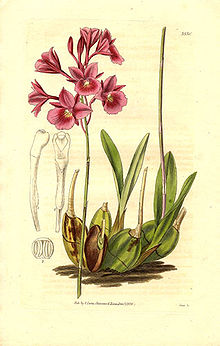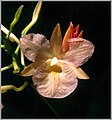
Orchids are plants that belong to the family Orchidaceae, a diverse and widespread group of flowering plants with blooms that are often colourful and fragrant.
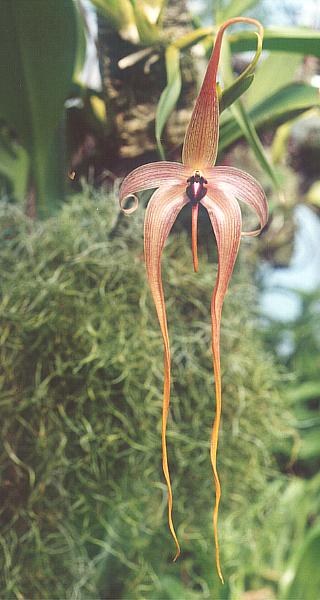
Bulbophyllum is a genus of mostly epiphytic and lithophytic orchids in the family Orchidaceae. It is the largest genus in the orchid family and one of the largest genera of flowering plants with more than 2,000 species, exceeded in number only by Astragalus. These orchids are found in diverse habitats throughout most of the warmer parts of the world including Africa, southern Asia, Latin America, the West Indies, and various islands in the Indian and Pacific Oceans. Orchids in this genus have thread-like or fibrous roots that creep over the surface of trees or rocks or hang from branches. The stem is divided into a rhizome and a pseudobulb, a feature that distinguished this genus from Dendrobium. There is usually only a single leaf at the top of the pseudobulb and from one to many flowers are arranged along an unbranched flowering stem that arises from the base of the pseudobulb. Several attempts have been made to separate Bulbophyllum into smaller genera, but most have not been accepted by the World Checklist of Selected Plant Families.

Cattleya is a genus of orchids from Costa Rica south to Argentina. The genus is abbreviated C in trade journals.

Laelia is a small genus of 25 species in the orchid family (Orchidaceae). Laelia species are found in areas of subtropical or temperate climate in Central and South America, but mostly in Mexico. Laelia is abbreviated L. in the horticultural trade.
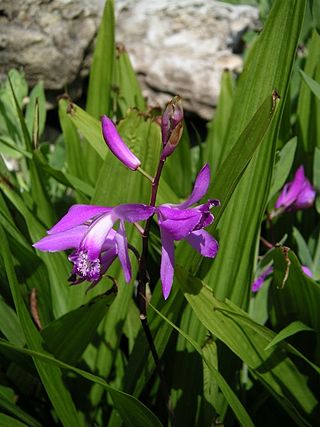
Bletilla, common name urn orchid, is a temperate, terrestrial genus of orchids containing five currently recognized species distributed through China, Japan, Taiwan, south to Vietnam, Thailand and Myanmar. The name is actually a diminutive of Bletia because of the resemblance between the two genera even though Bletia is a New World genus. The genera JimensiaRaf. and PolytomaLour. ex Gomes are generally included into Bletilla. This genus is abbreviated Ble in trade journals.

Dendrochilum glumaceum, the hay-scented orchid or husk-like dendrochilum, was described by John Lindley in 1841. It is an elegant looking epiphytic or lithophytic dendrochilum that occurs in the Philippines and Borneo at altitudes between 700 and 2,300 m.

Laelia speciosa, commonly known as the Mayflower orchid, is a species of showy orchid found in area of Mexico with high elevation of 1,400 m (4,593 ft) to 2,400 m (7,874 ft). The plant is very drought resistant and can tolerate cool to warm conditions. It blooms from summer to fall, producing fragrant flowers. There are usually three to four flowers on an inflorescence.
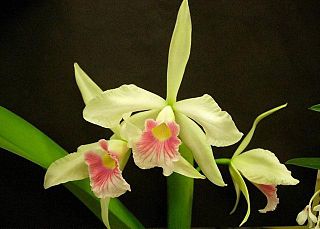
Cattleya purpurata, known in the past as Laelia purpurata and Sophronitis purpurata, is native to Brazil where it is very popular among orchid growers. It is an epiphyte that is found in the canopy of tall trees near coastal areas, in the Brazilian states of Rio Grande do Sul, Santa Catarina and São Paulo. The orchid favors bright light and cool to warm conditions and is relative easy to cultive. C. purpurata has been used extensively as a parent in hybridizing with Cattleyas. Cattleya purpurata blooms from late spring to fall with three to five flowers on a spike. The flowers are long-lasting and fragrant.

Dendrobium kingianum, commonly known as the pink rock orchid, is a flowering plant in the orchid family Orchidaceae and is endemic to eastern Australia. It usually grows on rocks, rarely as an epiphyte, and has thin, spreading leaves and spikes of up to fifteen, usually pink flowers in late winter to spring. It is popular in Australian native horticulture and is a commonly cultivated orchid among Australian orchid species growers.

Cattleya aclandiae, or Lady Ackland's cattleya, is a species of orchid from the genus Cattleya, named in honor of Lady Lydia Elizabeth Ackland, wife of Sir Thomas Dyke Acland, 10th Baronet who was the first European to grow the plant successfully. The illustration of the plant which accompanied its first description was based on a drawing by Lady Ackland. The genus was named in honour of William Cattley, a prominent British merchant and horticulturist.
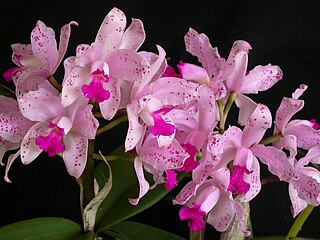
Cattleya amethystoglossa is a bifoliate species of orchid from the genus Cattleya.
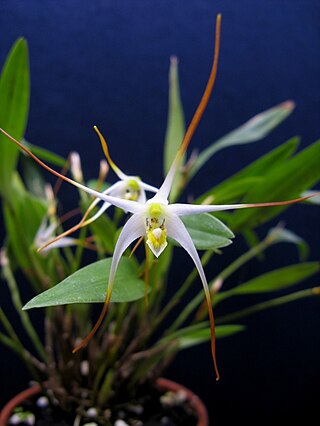
Dendrobium validicolle is a species of orchid. Its common name is the strong-stemmed diplocaulobium.

Aganisia cyanea is a showy species of orchid native to Colombia, Venezuela, Peru and Brazil and widely cultivated elsewhere as an ornamental. It is remarkable because some cultivars of this species produce blue flowers, the color blue being quite rare among the orchids. They are considered difficult to maintain in cultivation without a controlled growing environment.
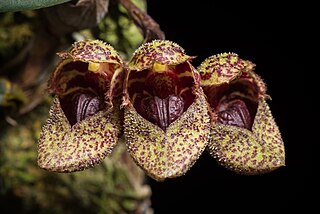
Bulbophyllum frostii, commonly known as Frost's Bulbophyllum or Dutchman's shoes is a species of orchid, In the wild it grows as an epiphyte, inhabiting evergreen seasonal lowland rainforests in Vietnam and more rarely in Thailand, including the Malay peninsula. It was more recently reported growing in the Yunnan province of China during a series of botanical surveys between 2017 and 2020. This plant is usually found at elevations of around 1500m above sea level.

Cattleya maxima is a species of orchid in subfamily Epidendroideae found from Ecuador to Peru.

Maxillaria tenuifolia, the delicate-leafed maxillaria or coconut pie orchid, is a species of orchid ranging from Mexico to Nicaragua and possibly Costa Rica. These plants are easy to grow if kept moist and given good air movement in a high-light windowsill of any orientation but North.

Isabelia is an orchid genus formed by three tiny species and one natural hybrid, spread from the Northeast of Brazil to Argentina, which are closely related to the genus Constantia. During more than a century Isabelia was a genus formed by just one species, however, around 1968, it was merged with genus Neolauchea, also unispecific. In 2001, a third genus was added to it, Sophronitella. The genus name is abbreviated Isa. in cultivation.

Cattleya cernua, commonly known as the nodding sophronitis, is a species of orchid occurring from Brazil to northeastern Argentina. It was the type species of the genus Sophronitis until the genus was made synonymous with Cattleya. Twenty plants of C. cernua have received a total of 22 AOS awards. The described flowers range from 1.9 cm to 3.2 cm horizontal spread and from 2.0 cm to 3.0 cm vertical spread.

Cattleya rex is a species of epiphytic orchid of showy white flowers, native to montane forests in Peru and Bolivia.

Psychopsiella is a monotypic genus in the orchid family found only in the state of Rio de Janeiro in Brazil and near Caracas in Venezuela. It grows as an epiphyte in evergreen montane forests at elevations of 800 to 1,500 metres.

